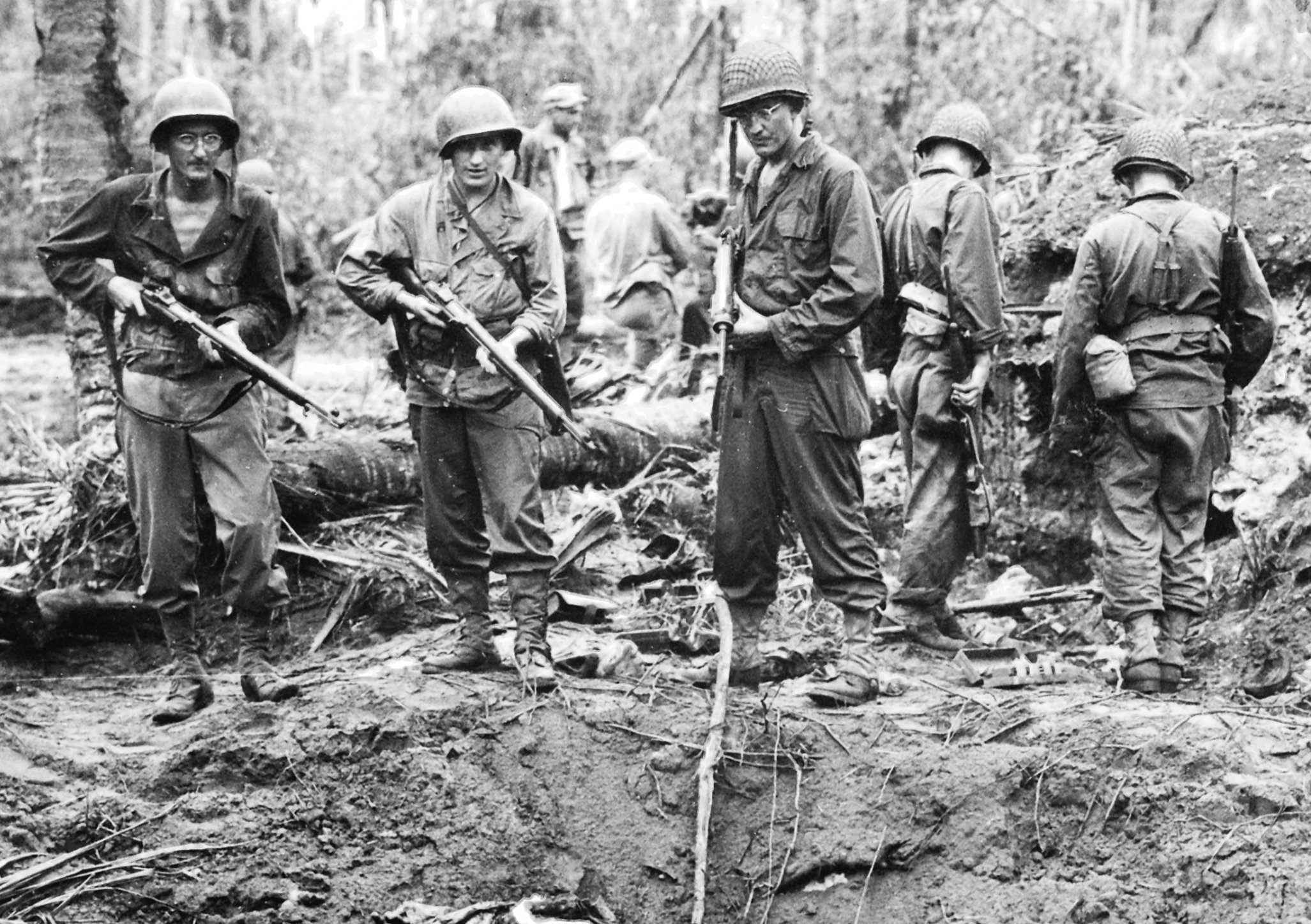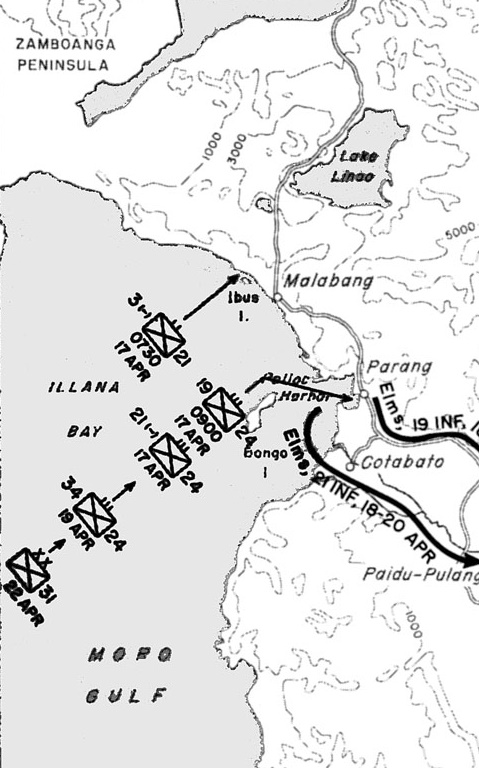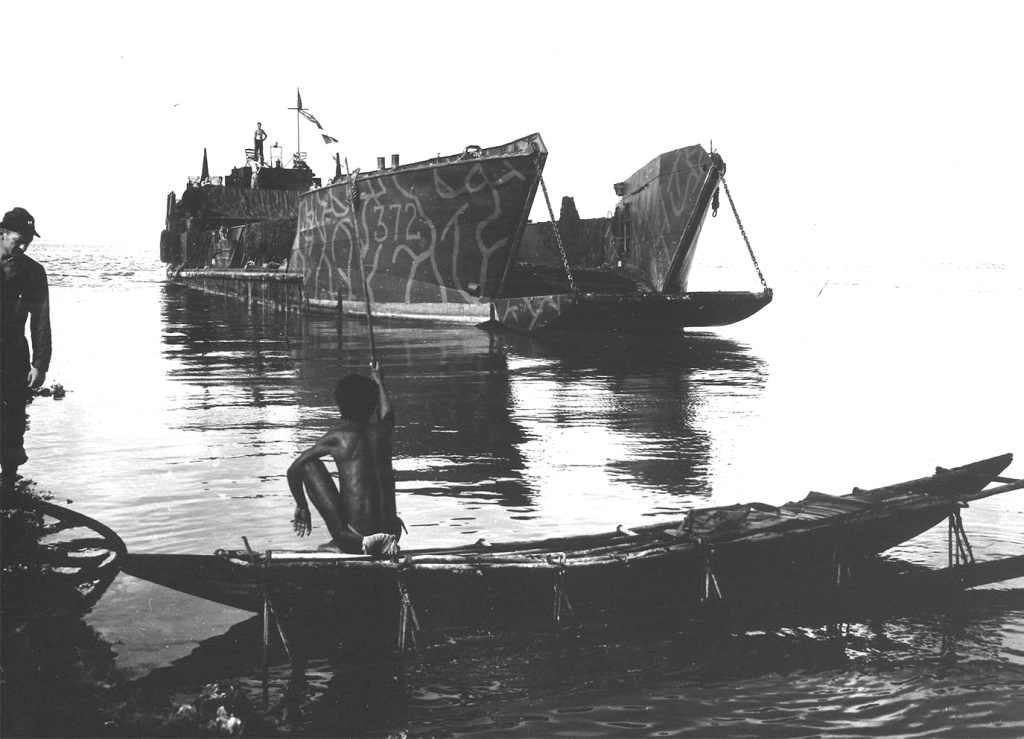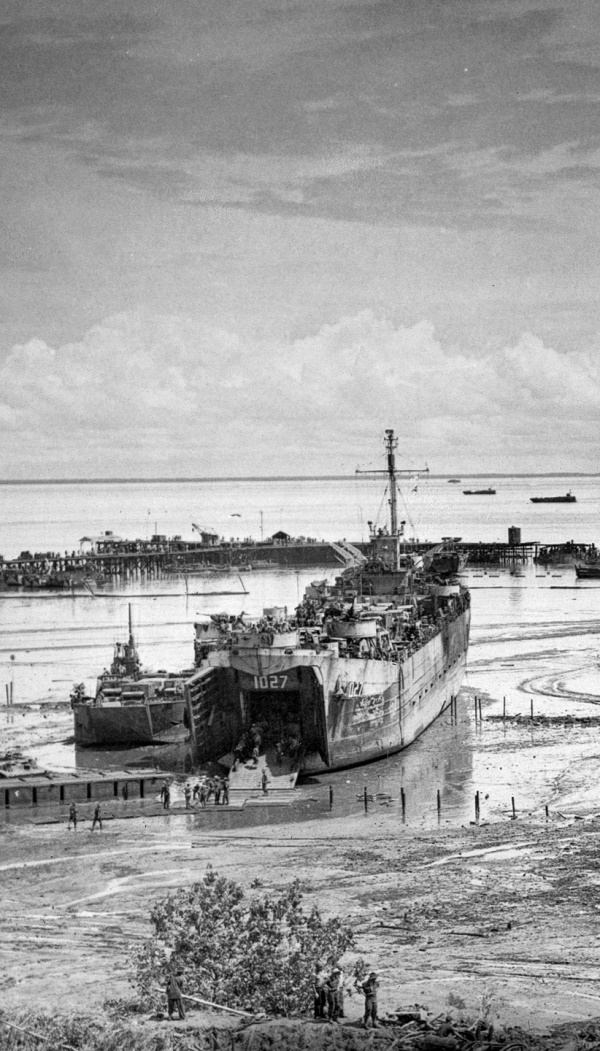The Division was alerted for the Invasion of Mindanao (Victor V) by Warning Order #5 of HQ 8-A dated March 5, 1945, ‘R’ Day was designated as April 17, 1945. At the time of receipt of the Warning Order, the division command post was situated on the Island of Mindoro where it had moved following relief on Leyte in early February 1945. Approximately 65% of the combat elements of the division had been detached since late December 1944 and were engaged as operational attachments to major units fighting on Luzon. This was believed necessary due to the overall limited troop strengths available in the theater at that time. One infantry regiment (-) and two field artillery battalions remained under division control in Mindoro. These units were engaged in small-unit amphibious combat missions on Mindoro and adjacent islands. The division service elements and division staff were engaged with the dual mission of refitting available division units as well as functioning as a provisional island command for Mindoro to include an operation of port facilities, supply dumps, supply points, heavy construction of fixed installations as well as establishment and operation of a staging area for other major ground units. Also, additional logistical functions were performed to support major combat units currently fighting on Luzon. The island command task was a large and exacting mission inasmuch as it required the substantial development and operation of a seizable base in minimum time on an island just recently wrested from the Jap. The detached combat elements did not return to division control on Mindoro until approximately three weeks prior to the embarkation date selected for Victor V. These three weeks offered no time for urgent combined training of any kind. By necessity, the main effort was made on rehabilitation and refitting in view of a prolonged operation ahead.
 Unit training on the company and battalion level was conducted to orient replacements that had joined at this time (statement of Col Gen Hugh. Some combat units had been continuously in action for six months in the various Philippine operations with little opportunity for suitable rest periods. During the planning phase of the operation, the division staff worked on the maze of operational and logistical details necessary for the coordination and success of an amphibious division assault in addition to the extra mission of conducting the Mindoro base development and functioning. Relief finally was obtained from the base operations mission on or about April 5, 1945, when a small detachment of HQ Eighth Army Area Command arrived on the Island and started to assume responsibility for the continuing base functioning.
Unit training on the company and battalion level was conducted to orient replacements that had joined at this time (statement of Col Gen Hugh. Some combat units had been continuously in action for six months in the various Philippine operations with little opportunity for suitable rest periods. During the planning phase of the operation, the division staff worked on the maze of operational and logistical details necessary for the coordination and success of an amphibious division assault in addition to the extra mission of conducting the Mindoro base development and functioning. Relief finally was obtained from the base operations mission on or about April 5, 1945, when a small detachment of HQ Eighth Army Area Command arrived on the Island and started to assume responsibility for the continuing base functioning.
Division Plan
 As discussed previously, the GHQ tactical directive as implemented by the 8-A gave the division no alternative but to formulate attack plans utilizing only one landing beach at Malabang, enlarging it into a suitable beachhead to support logistically the island operation to follow. Accordingly, the plan devised by the division for the Malabang landing provided for the 19th Regimental Combat Team to land on the south flank of the division beach, block off the town of Malabang and a secondary airfield on the north flank, then with a highly mobile battalion, lightly equipped with a sole mission of making time, break away to the south to seize Parang. The 21st Regimental Combat Team was to land abreast of the 19-RCT on the north flank of the division beach, seize the Malabang Airfield, gain contact with any guerrillas to the north, and establish a beach suitable for landing of LSTs. The 34-RCT, in division reserve, to be held afloat at Zamboanga, was to land at Parang at ‘R’ plus 2 days in the beachhead which was to be established by that time by elements of the 19-RCT. From past experience, all echelons of command had learned to keep plans simple and therefore flexible at all times when coordinated amphibious operations were involved.
As discussed previously, the GHQ tactical directive as implemented by the 8-A gave the division no alternative but to formulate attack plans utilizing only one landing beach at Malabang, enlarging it into a suitable beachhead to support logistically the island operation to follow. Accordingly, the plan devised by the division for the Malabang landing provided for the 19th Regimental Combat Team to land on the south flank of the division beach, block off the town of Malabang and a secondary airfield on the north flank, then with a highly mobile battalion, lightly equipped with a sole mission of making time, break away to the south to seize Parang. The 21st Regimental Combat Team was to land abreast of the 19-RCT on the north flank of the division beach, seize the Malabang Airfield, gain contact with any guerrillas to the north, and establish a beach suitable for landing of LSTs. The 34-RCT, in division reserve, to be held afloat at Zamboanga, was to land at Parang at ‘R’ plus 2 days in the beachhead which was to be established by that time by elements of the 19-RCT. From past experience, all echelons of command had learned to keep plans simple and therefore flexible at all times when coordinated amphibious operations were involved.
Staff planning for the amphibious phase of the operation was made more difficult by a drastic decrease in the amount of amphibious shipping normally allocated for a similar over-water tactical lift of the division. This was undoubtedly due to heavy demands for amphibious vessels throughout the Philippines to support the numerous concurrent operations then in progress. As a partial solution to this problem, the 8-A directed a 25% cut in motor vehicles normally taken on a tactical operation by all participating organizations. This was a severe jolt inasmuch as infantry divisions in the Pacific operated under special theater equipment allocations which authorized far fewer motor vehicles than the standard Tables of Equipment (T&O) then in use by the War Department. Even final shipping allocations did not become firm until the actual embarkation date due to constant withdrawal and substitution of shipping by higher headquarters or unavailability of vessels due to damage and repairs. The final division amphibious lift was accomplished with the following shipping, 1 Amphibious Flagship (Navy, Corps, Div Commander’s party); 1 Cutter, Coast Guard type; 26 LSTs; 10 LSMs; 13 LCIs and 6 LCTs.
US LCT (Landing Craft Tank)
This shipping lifted the three RCTs and portions of the division service units for R Day and R 2 Days landings. The shipping lists required close editing due to a lack of passenger space. Some service elements normally included in the close support were, by necessity, placed in the rear echelon shipping. After completing the discharge of the assault personnel and cargo at the objective area, the amphibious shipping planned to shuttle to Kindoro to lift the unit’s rear echelons and the balance of the division supplies. The return schedule provided for the rear echelons and supplies to arrive at the objective area by R 10 Days. One Liberty-type ship joined the return convoy at Mindoro, assisting in moving part of the 30-day supply level of Class I, II, III, and IV (less Engineer) and three Units of Fire. This supply level was prescribed by Eighth Army and was normal for an amphibious operation of this size. Obviously, the bulk and tonnages represented in this level could not be lifted with the assault elements. Sufficient supplies accompanied the assault force to sustain operations until such time as the rear echelons and supplies would arrive. With this tactical and amphibious movement plan completed, the assault echelons commenced loading operations on April 10, 1945, on excellent loading beaches in the Mindoro Harbor. By the darkness of April 12, all vessels had completed loading personnel and equipment and had retracted from the beach to await sailing orders.
On the morning of April 13, a few hours before the scheduled departure of the convoy, a radio message from the 8-A was received aboard the flagship to the effect that the Filipino Guerrillas had forced the Jap evacuation of Malabang and therefore the division was ordered to change its assault beach from Malabang to Parang, 10 miles to the south. In the matter of minutes available before sailing under radio silence, the division commander revised his tactical plan to provide for the 19-RCT to make the initial division assault landing at Parang with the mission of moving out immediately on the road to the southeast; the 21-RCT (minus one battalion making a Malabang landing as originally planned to ensure the retention of the Malabang Airfield) was to follow over the same beach, reorganize and prepare to move out on order; the 34-RCT, in division reserve, was to land as originally planned on R plus 2 Days. This changed landing plan was verbally distributed to all assault elements prior to sailing and later confirmed by a field order. By 1300, April 15, (a Friday the thirteenth) the convoy sailed southward for the assault of Mindanao.
G-1 Situation
The division G-1 staff section consisted of the following personnel during World War II, 1 Lt Col, GSC; 1 Maj, GSC; 1 M/Sgt; 1 T/4; Div G-1; Asst Div G-1; Chief Clerk and Clerk-Typist. For office space, this staff section operated normally in one standard pyramidal tent for both combat and rest area phases. The tentage served adequately for blackout purposes for night operations when required by the situation. During the pre-planning phase for Victor V, the G-1 section was located in the division command post in Mindoro. The section handled a normal volume of personnel business consistent with the existing tactical situation. Although 65% of the command had been detached operationally for combat, the administrative responsibility for these units still remained with the Commanding General, 24-ID. Unit personnel sections remained on Mindoro with small rear echelon detachments when their parent units were released for these detached operations. Therefore a normal flow of administrative matters was maintained with only slight delays due to the transmission of correspondence and reports by air courier mail from the detached parent units.
G-1 was involved in the Mindoro base operations to a limited degree only. Additional functions included the furnishing of considerable personnel by MOS for the non-table of organization positions required in the provisional base operations to supplement the division service elements already committed to this project. Securing native labor from the hill country of the island for port stevedore duty also was made a G-1 function. Assistance was given to several Filipino recruiting teams operating in the vicinity with GHQ approval in attempts to secure enlistments of Filipino Guerrillas and civilians for the Philippine Army. Replacements were received in limited quantities during this period and were assigned equitably by MOS and branches of service to units most critically in need of replenishment of strength. To fully understand the personnel and replacement situation within the division it is necessary to discuss briefly the directives of higher headquarters at the time of the operational detachment of troops referred to above. When the 19-RCT (-) and the 34-RCT were detached for the Luzon operations it was ordered by higher headquarters that both organizations be brought up to the T&O strengths. At that time the division was under strength with no immediate prospects of replacements. To comply with this directive it was necessary for experienced infantrymen to be transferred from the remaining 21-IR in sufficient numbers to bring the 19-RTC and the 34-RCT up to the T&O strength. When replacements were finally received sometime later the bulk of the replacements necessarily went to the 21-IR to balance their excessive under-strength. This posed a seizable training problem and affected the combat efficiency of that unit adversely as green recruits were substituted for the transferred combat infantrymen. When the detached units returned from Luzon it was decided that any advantages of the re-transferring of personnel back to the 21-IR would be outweighed by the disadvantages inasmuch as approximately three months had elapsed since the original shifting of personnel had taken place. This situation was to be reflected later in the Mindanao operation when the going was the toughest. Even though some replacements were received prior to the Mindanao operation the division embarked under strength. The Artillery units, due to low casualty rates were approximately at T&0 strengths. However, each Infantry battalion was under-strength about 100 infantrymen. The under-strength was about equal in all three infantry regiments. A small under-strength in the division service elements was not expected to affect the accomplishment of their mission as few casualties were expected in their ranks based on past experience.
During the pre-planning phase, the G-1 expressed interest in the vital morale-sustaining activities and factors contributing to morale during the rest period. A brief summary of these items is believed timely at this point. Morale activities of the division were coordinated with the Division Special Service Officer. An adequate supply of 16-MM entertainment films was provided during this period but maintenance and replacement of projection equipment were unsatisfactory due to a lack of adequate supply and repair facilities. Several USO entertainment units were booked for appearances when the bulk of the combat troops had returned from their Luzon missions. Athletic equipment was limited and in poor condition with replacement difficult to secure due to limited supply. As a morale-sustaining activity, post-exchange supplies were available in limited quantities during this rest period. Items were principally sweets and edibles that could stand up in tropical temperatures. These were regarded as delicacies as none had been available for some time. Limited supplies of current magazines were also available for sale as well as a few wristwatches, pens, and pencils. Of considerable moral significance was a monthly beer issue of four cans per man. In view of the complete lack of any indigenous beverages in the Islands, the importance of an adequate regular beer issue cannot be underestimated in a hot tropical climate. Army policy had established a monthly beer ration of one case per man per month. Unfortunately, this amount was never received by the combat troops and the rations seldom exceeded six cans per man per month.
A brief comment on the effect of the QM ration upon morale is believed pertinent at this time also. During the staging period in this area, the ration consisted of dehydrated and tinned components entirely with bread being the only reasonably fresh item available. This situation created a vicious monotonous diet resulting in a general loss of weight throughout the command. This occurred at a time when fresh components, particularly meat, were sorely needed as it followed a period of sustained combat. Mail was received regularly by air from the Army Postal Regulating Station situated on Leyte. Airmail from the Zone of Interior in almost every instance arrived faster than the processed V-Mail. Parcel’s post continued to be slow and uncertain. Due to the deep personal interest of the division commander in the prompt receipt and distribution of mall within the command, the G-1 made a daily report to the Commanding General personally of the quantities of mail received by the Division APO for each 24-hour period and the time required to distribute the shipment to the subordinate postal sections. Prompt mail service was believed to be one of the greatest contributing factors to the excellent morale within the command at this time.
A small provisional casual camp was operated at all times under the supervision of the G-1. This organization was assisted by billeting casuals returning from hospitals, sorting, and delivery of personnel to the rear echelons of division units. Normally, replacements were received in such large numbers that the casual camp was unable to accommodate them. In such cases, assignment to units without delay was imperative. No rest camps of any type were available at this time or any other time to division personnel. During the rest period, all organizations were urged by the G-1 to hold unit ceremonies for the presentation of awards and decorations. This was deemed essential as some units had not made a formal presentation of awards for the Leyte Campaign which had taken place some six months prior to this period.





















